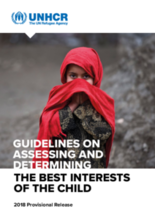In 2008, UNHCR released the UNHCR Guidelines on Determining the Best Interests of the Child (2008 BID Guidelines), and added its accompanying Field Handbook in partnership with IRC in 2011. For the last 10 years, these tools have provided staff and partners with practical guidance, processes and tools on applying the best interests principle in decisions affecting children at risk in particular children who are separated from their parents and families. Building on the practice of strengthening national child protection systems and on 10 years of implementation of UNHCR’s Guidelines on Determining the Best Interests of the Child (Best Interests Determination (BID) Guidelines) (May 2008), these updated BIP Guidelines replace both the 2008 BID Guidelines and the 2011 Field Handbook for the Implementation of UNHCR BID Guidelines.
Read the Quick Guide to the BIP Guidelines here.
New features of these updated Guidelines include:
- The Best Interests Procedure is UNHCR’s case management process: The BIP Guidelines reinforce that the Best Interests Procedure is UNHCR’s tool for the case management of children at risk and not a separate or parallel process. The BIP thus includes identification, Best Interests Assessment, case planning and implementation, follow-up and closure of child protection cases, in addition to BID for those cases that require it.
- Strengthened guidance on working with national child protection systems: The importance of working with child protection systems is specifically underscored by UNHCR’s Executive Committee in its Conclusion on Children at Risk (no.107). The BIP Guidelines include additional guidance on how UNHCR should engage with national child protection systems in different contexts.
- Revised criteria for Best Interests Determinations: While the criteria for BID remain largely unchanged, there are two notable revisions:
- A BID remains necessary for durable solutions and complementary pathways for unaccompanied children, but is only required for separated children where there is an additional significant risk factor or protection concern.
- The possibility for context-specific BID criteria for other children at risk in exceptional situations has been introduced in recognition of the specific operational needs of different contexts and operations.
- Expanded practical guidance on key topics: These include: prioritisation, staffing and resources for BIP; child participation in BIP; information management for BIP; simplified BID procedures; and consensus decision-making instead of voting in BID Panels.
The BIP Guidelines are now issued as a provisional release until the end of 2019 to complete the process of feedback and validation from UNHCR staff and counterparts. In sharing this release with you, we invite you to use the BIP Guidelines in your daily work and we would welcome your feedback on any errors, inconsistencies or omissions you identify during your use of these updated guidelines. Please use this form to share your feedback. For more information and support or for any questions, please visit the Child Protection and Youth RefWorld page, or contact the Child Protection Unit at hqchipro@unhcr.org.

